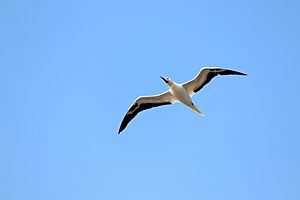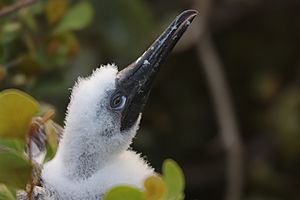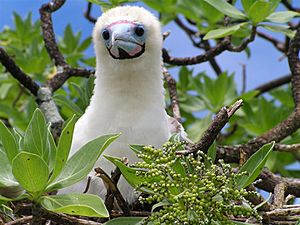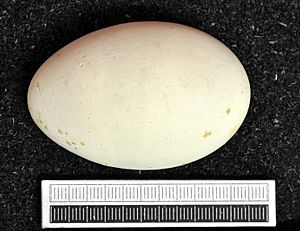Red-footed booby facts for kids
Quick facts for kids Red-footed boobyTemporal range: Holocene
|
|
|---|---|
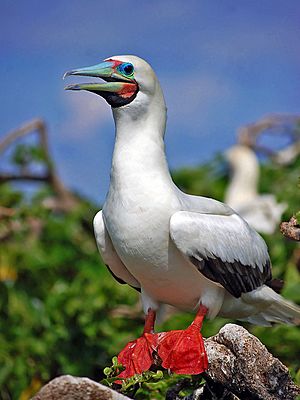 |
|
| White morph, Philippines | |
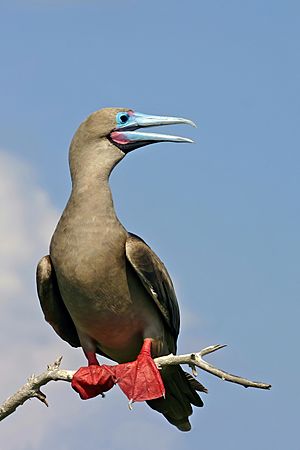 |
|
| Brown morph, male, Galápagos Islands | |
| Conservation status | |
| Scientific classification | |
| Genus: |
Sula
|
| Species: |
sula
|
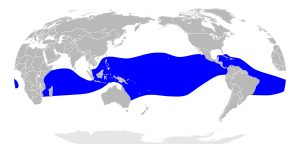 |
|
| Synonyms | |
|
|
The red-footed booby (Sula sula) is a large seabird that belongs to the booby family. These birds always have bright red feet! Their feathers can be different colors, but their feet are always red. Red-footed boobies are amazing flyers, very strong and quick in the air. However, they can be a bit clumsy when they take off or land. You can find them in warm, tropical parts of the world. They like to live and raise their young in big groups called colonies along coasts, especially on islands. Even though their numbers are slowly going down, experts believe they are not in immediate danger.
About Their Name
The first official description of the red-footed booby was made by a Swedish scientist named Carl Linnaeus in 1766. He gave it the scientific name Pelecanus sula. The word Sula comes from Norwegian and means "gannet," which is another type of seabird.
There are three main types, or subspecies, of red-footed boobies:
- S. s. sula (Linnaeus, 1766) – Found in the Caribbean and islands in the southwest Atlantic Ocean.
- S. s. rubripes Gould, 1838 – Lives in the tropical Pacific and Indian Oceans.
- S. s. websteri Rothschild, 1898 – Found in the eastern central Pacific Ocean.
What They Look Like
The red-footed booby is the smallest bird in the booby and gannet family. It is about 70 cm (28 in) (28 inches) long. Its wings can spread up to 152 cm (60 in) (60 inches) wide. On average, an adult bird weighs about 837 g (1.845 lb) (1.8 pounds).
Of course, they have red legs! Their bill and the skin on their throat are usually pink and blue. These birds can have different feather colors, which scientists call "morphs."
- The white morph is mostly white, but its head might look a bit yellow. Its flight feathers (the long feathers on its wings) are black.
- The black-tailed white morph looks similar but has a black tail.
- The brown morph is mostly brown all over.
- The white-tailed brown morph is brown but has a white belly, bottom, and tail.
- The white-headed and white-tailed brown morph has a mostly white body, tail, and head, with brown wings and back.
These different colored birds often breed together. However, in most places, one or two colors are more common. For example, on the Galápagos Islands, most red-footed boobies are the brown morph.
Both male and female birds look very similar. Young birds are brownish with darker wings and pale pinkish legs. Baby chicks are covered in soft, white fluffy down.
A red-footed booby was found in the UK in 2016, which was very unusual. It was cared for and then flown to the Cayman Islands. Another one was seen in New Zealand in 2017 for the first time. In 2016, a large coconut crab was seen hunting a red-footed booby on the Chagos Archipelago.
Reproduction
Red-footed boobies breed on islands in most tropical oceans. When they are not breeding, they spend most of their time out at sea. This is why you usually only see them near their breeding colonies. They build their nests in large groups.
A female booby lays one chalky blue egg in a nest made of sticks. Both parents take turns sitting on the egg to keep it warm for about 44 to 46 days. Their nests are usually built in trees or bushes, but sometimes they might nest on the ground. It can take about three months before the young birds take their first flight. It takes even longer, about five months, before they can fly long distances on their own.
Red-footed booby pairs often stay together for many breeding seasons. They have special ways of greeting each other. These greetings include loud squawks and the male showing off his bright blue throat. They might even do short dances!
What They Eat
Red-footed boobies are excellent divers. They dive into the ocean at very high speeds to catch their food. They mostly eat small fish or squid. These small creatures often swim together in groups near the surface of the water.
Conservation
The International Union for the Conservation of Nature (IUCN) says the red-footed booby is a species of least concern. This means they are not currently in danger of disappearing. However, their numbers are slowly going down around the world. For example, during a warm period called El Niño in 1982 and 1983, the water temperatures became higher. This made it harder for the boobies to find food. On Christmas Island, where usually 6,000 pairs would nest, only about 30 to 60 pairs tried to breed during those years.
See also
 In Spanish: Piquero patirrojo para niños
In Spanish: Piquero patirrojo para niños



